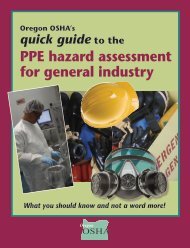Technical Manual - Section 3 (Safety Hazards)
Technical Manual - Section 3 (Safety Hazards)
Technical Manual - Section 3 (Safety Hazards)
You also want an ePaper? Increase the reach of your titles
YUMPU automatically turns print PDFs into web optimized ePapers that Google loves.
D. DESCRIPTION OF PETROLEUM REFINING<br />
PROCESSES AND RELATED HEALTH AND SAFETY<br />
CONSIDERATIONS<br />
CRUDE OIL PRETREATMENT<br />
(DESALTING)<br />
Crude oil often contains water, inorganic salts, suspended<br />
solids, and water-soluble trace metals. As a first step in the<br />
refining process, to reduce corrosion, plugging, and fouling<br />
of equipment and to prevent poisoning the catalysts in<br />
processing units, these contaminants must be removed by<br />
desalting (dehydration).<br />
The two most typical methods of crude-oil desalting,<br />
chemical and electrostatic separation, use hot water as the<br />
extraction agent. In chemical desalting, water and chemical<br />
surfactant (demulsifiers) are added to the crude, heated so that<br />
salts and other impurities dissolve into the water or attach to<br />
the water, and then held in a tank where they settle out.<br />
Electrical desalting is the application of high-voltage<br />
electrostatic charges to concentrate suspended water globules<br />
in the bottom of the settling tank. Surfactants are added only<br />
when the crude has a large amount of suspended solids. Both<br />
methods of desalting are continuous. A third and<br />
less-common process involves filtering heated crude using<br />
diatomaceous earth.<br />
The feedstock crude oil is heated to between 150 o and 350 o F<br />
to reduce viscosity and surface tension for easier mixing and<br />
separation of the water. The temperature is limited by the<br />
vapor pressure of the crude-oil feedstock.<br />
In both methods other chemicals may be added. Ammonia is<br />
often used to reduce corrosion. Caustic or acid may be added<br />
to adjust the pH of the water wash.<br />
Wastewater and contaminants are discharged from the bottom<br />
of the settling tank to the wastewater treatment facility. The<br />
desalted crude is continuously drawn from the top of the<br />
settling tanks and sent to the crude distillation (fractionating)<br />
tower.<br />
HEALTH AND SAFETY CONSIDERATIONS<br />
Fire Prevention and Protection<br />
The potential exists for a fire due to a leak or release of crude<br />
from heaters in the crude desalting unit. Low boiling point<br />
components of crude may also be released if a leak occurs.<br />
<strong>Safety</strong><br />
Inadequate desalting can cause fouling of heater tubes and<br />
heat exchangers throughout the refinery. Fouling restricts<br />
product flow and heat transfer and leads to failures due to<br />
increased pressures and temperatures. Corrosion, which<br />
occurs due to the presence of hydrogen sulfide, hydrogen<br />
chloride, naphthenic (organic) acids, and other contaminants<br />
in the crude oil, also causes equipment failure. Neutralized<br />
salts (ammonium chlorides and sulfides), when moistened by<br />
Table III:2-4: DESALTING PROCESS<br />
Feedstocks From Process Typical products............ To<br />
Crude Storage Treating Desalted crude..........Atmospheric distillation tower<br />
Waste water..........................Treatment<br />
III:2-15
















